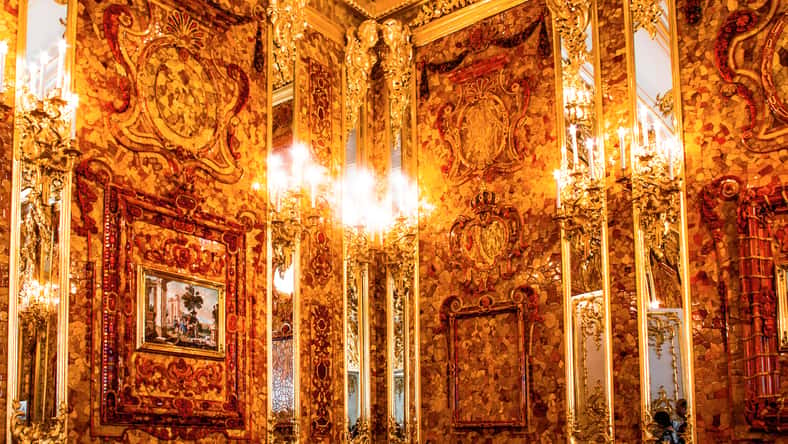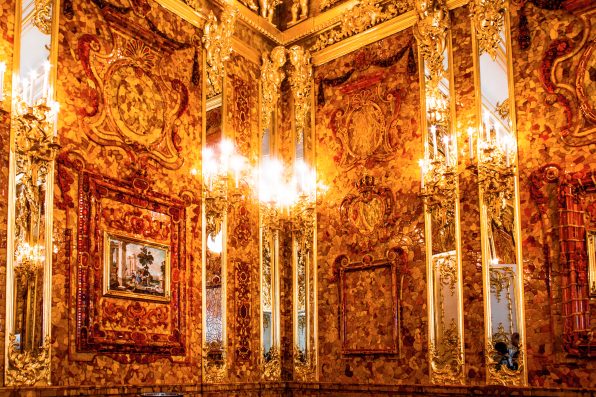The Curious Case Of The Vanishing Amber Room Is One Of The Greatest Mysteries Of World War II

After the Nazis swept into Russia during World War Two, they took over the Catherine Palace and looted thousands of valuable treasures, including the Amber Room.
The room had been dubbed “the Eighth Wonder of the World and was one of Russia’s most prized artifacts.
It was made of several tons of amber, hence its name. The space also radiated with warmth and glowed like honey.
The Amber Room was a gift to Peter the Great in 1716 to celebrate the peace between Russia and Prussia.
The collection of shimmering amber panels was shipped to Germany and put on display. However, in the final months of the war, the amber panels vanished.
In 2003, a replica was constructed, but the original Amber Room has remained missing ever since. Its fate is one of the greatest mysteries of World War Two.
The work of art dated back to 1701 when Andreas Schlüter, a German baroque sculptor, began designing it.
At the time, the use of amber for interior decoration had been completely unheard of, but Schlüter had a vision, and he was determined to bring it to fruition.
The amber was dipped in a mix of honey and linseed before they were worked into panels of wood. The wood was covered in gold and silver leaf and decorated with precious jewels.

Alexandra Lande – stock.adobe.com – illustrative purposes only, not the actual person
The Amber Room was initially installed in Charlottenburg Palace in Berlin. The palace was home to Freidrich I, the first king of Prussia.
When Peter the Great saw the space during a visit in 1716, he expressed his admiration for it. The king, then Frederick William I, gave it to Peter, establishing an alliance between Prussia and Russia against Sweden.
And so, the panels were taken apart and shipped to Russia in 18 large boxes. It was set up in the Winter House in St. Petersburg, where it was shown off as a European art collection.
In 1755, Peter’s daughter Elizabeth had the room moved to the Catherine Palace in Pushkin. Several craftsmen redesigned the room to fit the new, larger space.
After renovations were completed, the room covered around 180 square feet and was adorned with six tons of amber, along with other precious stones.
The room had a certain grand splendor and dazzled anyone who stepped foot in it. Estimates have placed its worth at $142 million today.
On June 22, 1941, Adolf Hitler sent three million German soldiers into the Soviet Union as part of Operation Barbarossa.
As his forces closed in on Pushkin, palace officials tried to conceal the Amber Room. When they attempted to take it apart, they discovered that the amber panels were too delicate and brittle for such hasty removal. Instead, they covered the room with a thin layer of wallpaper.
However, the ruse failed. German soldiers tore down the Amber Room, packed the panels into crates, and shipped them back to Germany within 36 hours.
The room was reinstalled in Königsberg castle on the Baltic Coast. In late 1943, the end of the war was approaching.
The museum’s director was instructed to dismantle the room and pack it into crates. But the following year, bombs rained down on the city, destroying the castle museum. Afterward, the contents of the Amber Room were lost forever.
The most obvious theory as to the disappearance of the Amber Room is that it was blown to smithereens during the bombings of 1944.
Some believe the amber panels were loaded onto a ship and ended up at the bottom of the Baltic Sea, while others think that they’re still in the city somewhere.
In 1997, German art detectives investigated a report of someone trying to sell a piece of the Amber Room.
When they raided the office of the seller’s lawyer, they found one of the room’s mosaic panels. The seller turned out to be the son of a dead soldier and was unaware of the panel’s origins.
Another bizarre theory is that Stalin had a second Amber Room, and the Germans actually stole a fake.
In 1979, the construction of a new Amber Room was ordered. It was finished 25 years later at a cost of $11 million. It is currently on display at the Tsarskoye Selo State Museum Reserve on the outskirts of St. Petersburg.
Sign up for Chip Chick’s newsletter and get stories like this delivered to your inbox.
More About:News





